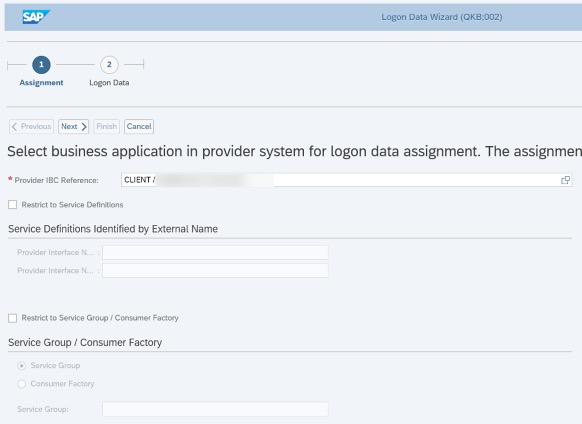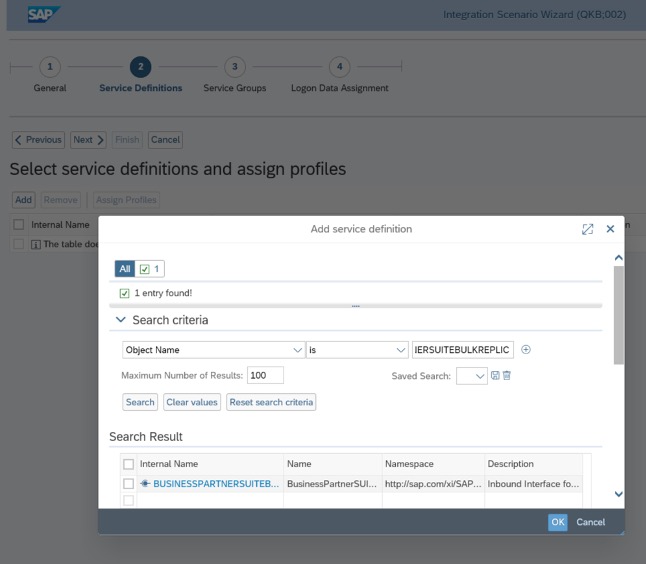
- SAP Community
- Products and Technology
- Enterprise Resource Planning
- ERP Blogs by SAP
- S/4HANA Business Partner Replication
- Subscribe to RSS Feed
- Mark as New
- Mark as Read
- Bookmark
- Subscribe
- Printer Friendly Page
- Report Inappropriate Content
Introduction and Scenario
You have set up your business partner scenario in your S/4HANA system? Now you want to send your S/4HANA business partners to another S/4HANA system?
This blog provides you the steps for a basic scenario: sending your business partner master data from one S/4HANA on premise system to another with some snapshots. Being a member of the business partner team of the S/4HANA RIG, I want to share this with you.
Let´s assume business partners (BP’s) like this BP customer:

Which technology should you use for the replication? Web services or IDocs?
The answer is clearly given in note 2417298 - Integration of Business Partner with Customer and Supplier Roles: the web service technology of Enterprise Service Oriented Architecture (SOA) is to be used, if the system has business partners. The IDocs DEBMAS and CREMAS are not recommended for data integration between S/4HANA systems. For business partner replication, the web service technology is also used by S/4HANA Master Data Governance (MDG) and SAP Cloud Platform Master Data for Business Partner. Additonally, there are odata services for business partner master data available, but their usage is not scope of this blog.
Detailed reference information about the business partner web service definitions with all fields can be found here.
So, what set up steps needs to be done? Don´t get confused, when MDG is mentioned in linked documentation sometimes. It´s, because technically it´s part of S/4HANA, but you don´t need to set up the complete MDG for this.
There are two major steps:
- SOA manager basics on sender and receiver
First you need to do the basic configuration in the SOAMANAGER (SOA Manager) transaction. It starts the SOA Manager web application. I will describe the steps below. For your reference, here´s also the link to help.sap.com. - Configuration in Data Replication Framework (DRF)
The Data Replication Framework enables you to replicate data from a source system to target systems. I will describe how to configure it for this sceanrio below. For your reference, here´s also the link to help.sap.com.
Configuring SOA Manager for Business Partner
Before you set up the data replication framework (DRF), you need to configure the SOA Manager accordingly in receiver and provider system.
Preparation
Do these steps as preparation in both receiver and provider system;
- Get administrative authorizations for the SOA manager in S/4HANA: SAP_BC_WEBSERVICE_ADMIN_TEC and authorization for transactions SU01, SUIM, PFCG.
- Create a special service user in transaction SU01 with authorization role SAP_BC_WEBSERVICE_ADMIN_TEC.
- Activate special business functions from SOA and business partner.
Run this activity in the customizing: SAP Customizing Implementation Guide > Activate Business Functions. Active business function FND_SOA_REUSE_1. - Activate point-to-point communication for enterprise services
Run this activity in the customizing: SAP Customizing Implementation Guide > Cross-Application Components > Processes and Tools for Enterprise Applications > Enterprise Services > Point-to-Point Enablement for Asynchronous Enterprise Services > Activate Support for Point2Point Communication. - Connect to the system landscape directory or implement a BAdI for local system ID determination as described in the IMG doucmentation here: Cross-Application Components > Processes and Tools for Enterprise Applications > Master Data Governance > General Settings > Data Replication > Define Custom Settings for Data Replication > Define Technical Settings > BAdI: Determination of Local System Name
- Configure the web service runtime as described in note 1043195 - Configuration of Web service runtime
- Activate the error and conflict handler (optional, recommended) in IMG Cross-Application Components > General Application Functions > Error and Conflict Handler > Activate Error and Conflict Handler.
CONFIGURE the SOA MANAGER
Do these steps as preparation to configure the SOA Manager in both receiver and provider system;
- Create a point-to-point communication profile with same name in provider and receiver.

- Configure the client setting.
Go to Technical Administration > SAP Client Settings in the SOA Manager, provide an organization name and either get the business system from System Landscape Directory (if you use it) or if you have used the BAdI, provide local system ID as defined in the BAdI MDG_IDM_GET_LCL_SYSTEM.
Then enter the own business system ID. You can get the own business system ID from transaction SLDCHECK and check in the transactions list report the section “Calling function LCR_GET_OWN_BUSINESS_SYSTEM”:

- Configure a provider system for the business scenario configuration.
Create the provider system on the Technical Administration tab of the SOA Manager.
On the General tab provide the name of the business system ID of the counterpart system, a description and as profile name enter the profile name from Step 1!

Enter further details on the next step “Enter connection settings for searching web services and credentials to access service metadata like WSDL and WSIL”. Use the primary service registry settings and the WSIL usage. Fill these fields
- SLD Identifier
Enter it in this format <client>.SystemName.<XYZ>.SystemNumber.<Installation Number>.SystemHome.<Host>.
SystemNumber you find under System>Status>SAP System Data>Installation Number and SystemHome under System>Status>Database Data>Host. - Access URL for WSIL and Logon Information
Format: https://<hostname>:<port>/sap/bc/srt/wsil?sap-client=<client>;
Host name and port you get from transaction SMICM (ICM Monitor), Goto > Services
- User and Password for WSDL and WSIL. You can take the service user you created in the backend system.

- Create Business Application ID
Enter an application name, description and the business application ID from the counterpart system. It can be found under SOAMANAGER > Technical Administration > SAP Client Settings in the counterpart system. Press Finish.The Identifiable Business Context Reference (IBC reference) for the counterpart system is generated automatically and can be checked in SOAMANAGER > Service Administration > Identifiable Business Context Reference.
- SLD Identifier
- Edit logon data for business scenario
After the backend users were created already earlier, please create appropriate Logon Data entries within both provider and receiver system locally. This can be done in the SOAMANAGER > Service Administration > Logon Data Management > Maintenance
- Assign Logon Data to Provider Identifiable Business Context (IBC) Reference
Now the just created Logon Data have to be assigned to the IBC References.
Press Next, assign the logon data and press Finish.
- Create Integration Scenario Configuration for Point-to-Point Communication using Service Group.With this, you select the business partner services for the communication. In SOAMANAGER go to Service Administration > Local Integration Scenario Configuration and create an integration scenario configuration.

Add these Service Definitions:
- BUSINESSPARTNERSUITEBULKREPLIC
- BUSINESSPARTNERSUITEBULKREPLI1
- BUSINESSPARTNERRELATIONSHIPSUI
- BUSINESSPARTNERRELATIONSHIPSU1

For all assign the above created profile MDG and press Next.
Then Select service groups and provider IBC reference by adding service group MDG_BS_SUPPLIERREPLICATEREQ and MDG_BS_SUPPLIERREPLICATECONF.

To all service groups assign the before created IBC Reference.

Check the Logon Data Assignment and Press Finish.
Do not activate the business scenario immediately because first the business scenario in the counterpart system needs to be defined.
After creation of the integration scenario in the counterpart system, activate the scenario and process pending tasks in both systems. - Set logical port as default
For setting the logical port, in SOAMANAGER go Service Administration > Web Service ConfigurationSearch Object Type: All and Object Name:BusinessPartnerSUITEBulkReplicateRequest_Out
Click on the BusinessPartnerSUITEBulkReplicateRequest_Out, select the logical port and press Set Log.Port Default.

Congratulations, you´ve set the SOA Manager! Most of the work is done. Now you only need to configure the Data Replication Framework.
Configuration in Data Replication Framework (DRF)
- Define technical settings for business system
- For settings in the DRF, in transaction DRFIMG, go to Data Replication > Define Custom Settings for Data Replication > Define Technical Settings > Define Technical Settings for Business Systems
- Create a new entry with the business system as you entered as provider system in SOA Manager under Technical Administration > Provider Systems and a logical system. As Business Object Type add 986 (Business Partner including Relationships) with Output Mode Object-Dependent Default with System Filter checked. As communication channel choose Replication via Services, further values as shown in snapshot.

- Define a replication model
- In transaction DRFIMG, go to Data Replication > Define Custom Settings for Data Replication > Define Replication Model.
- Create a new Replication Model entry, Assign Outbound Implementation 986_3 Outbound Impl. for BP/REL via Services, Communication Channel Replication via Services and Filter time Filter After Change Analysis. For the new Assignment line as next step create a new assignment line and enter the target business system for the replication model. Log Days can be set optional.
- Furthermore, set outbound parameters in Assign Outbound Parameter with Outbound Parameter “PACK_SIZE_BULK” for example with value 50 or 100.
- Save Active your replication model in Data Replication > Define Custom Settings for Data Replication > Define Replication Model.
Starting the Replication
Finally, you can start the replication via transaction DRFOUT. Select the previously created replication model and the respective outbound implementation. You get several options for the replication.

With the button Manual Replication Filter Criteria, you get to the filter screen. On the screen you can enter several filters, after done press Save. Back on the main screen, press Execute, and you trigger the data replication manually.

After e.g. a manual start you get the log:

Further detailed monitoring is possible via transaction SRT_MONI Web Service Utilities: Message Monitor.
Conclusion
This guidance should give a good starting point for business partner replication, especially if you haven´t worked with the SOA Manager and DRF before.
As this is just a starter, I bet there are many questions coming up as you evolve your scenario.
For questions please check these helpful links:
- See all questions and answers about SAP S/4HANA
- Ask a Question about SAP S/4HANA
- Follow SAP S/4HANA for more blogs and updates
- Visit the community topic pages for SAP S/4HANA
Brought to you by the SAP S/4HANA RIG and Customer Care team.
- SAP Managed Tags:
- SAP S/4HANA
You must be a registered user to add a comment. If you've already registered, sign in. Otherwise, register and sign in.
-
Artificial Intelligence (AI)
1 -
Business Trends
363 -
Business Trends
29 -
Customer COE Basics and Fundamentals
1 -
Digital Transformation with Cloud ERP (DT)
1 -
Event Information
461 -
Event Information
28 -
Expert Insights
114 -
Expert Insights
186 -
General
1 -
Governance and Organization
1 -
Introduction
1 -
Life at SAP
414 -
Life at SAP
2 -
Product Updates
4,679 -
Product Updates
267 -
Roadmap and Strategy
1 -
Technology Updates
1,499 -
Technology Updates
98
- Streamlining Customer Business Partner Creation in SAP Using BAPIs in Enterprise Resource Planning Q&A
- Expenses for retail customers who purchase products and expenses for people who provide services in Enterprise Resource Planning Q&A
- Dunning for CardCode not consolidating business partner in Enterprise Resource Planning Q&A
- Why YCOA? The value of the standard Chart of Accounts in S/4HANA Cloud Public Edition. in Enterprise Resource Planning Blogs by SAP
- Understand Upgrading and Patching Processes of SAP S/4HANA Cloud Public Edition in Enterprise Resource Planning Blogs by SAP
| User | Count |
|---|---|
| 7 | |
| 6 | |
| 4 | |
| 4 | |
| 4 | |
| 3 | |
| 3 | |
| 3 | |
| 3 | |
| 3 |